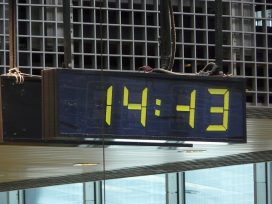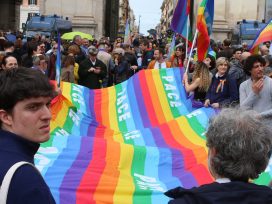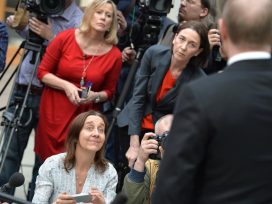Underneath Putin's ratings
An insidious obsession with ratings and the suppression of the opposition: this is all that Vladimir Putin’s rule hinges on now, writes Boris Dubin. However, right up until his recent death, the Russian sociologist continued to combine keen insights into Russia’s rotten political culture with a plea for a new, enlightened historical consciousness.
Boris Dubin died on 20 August 2014. This is the last article he wrote.
Russian sociologists noted rather early the Kremlin’s interest in certain symbolic undertakings that are addressed to all Russians. In addition, researchers observed a characteristic interest of the presidential administration in Putin’s ratings. Starting in the 2000s, they persistently stressed the merely ceremonial, or even mock, character of a regime that could have been characterized, in the words of Yuri Levada, as enjoying “high ratings instead of high achievements”.
Approval rating number one
Such a model of power needs mass media more than anything else, and especially television. Hence, under Putin, the media quickly came under state control, while the oligarchs, whose capital and interests had been behind those channels since the mid-1990s, were expelled and isolated. Today, television offers only the official interpretation of what is taking place in Russia and around the world. This communication strategy corresponds with the expectations and ideas shared by the majority in Russian society. What is more, it strengthens them in their beliefs, which are publicly expressed and acceptable to “all”. In this way, a majority is created within a society and this majority supports the actions of the president.
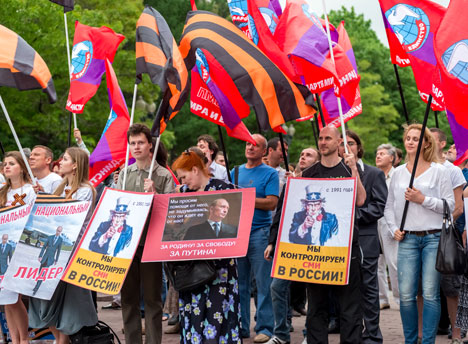
Pro-Putin meeting in Moscow, Russia, 18 May 2013. Placard with Uncle Sam reads “We control mass media in Russia since 1991”. Photo: elvistudio/Shutterstock.
That is why any sociologist who wants to study Russian society should analyse separately the significance of approval ratings for the authorities on the one hand, and the ability of ratings to depict social attitudes on the other. I too will try not to mix these two perspectives. Let me start with the social approval of Putin’s rule, the so-called “approval rating number one”. Right now, it is indeed impressively high and seemingly sustainable, something that can be explained by several factors. First, the image of a single ruler insisting on the country’s unity and promising stability appealed to many Russians, especially given the contrast between this image and the relatively diverse range of representation that the political scene offered in the 1990s, a period characterized by the growing unpredictability of Boris Yeltsin and the economic turbulence caused by aggressive economic reforms known as the “Gaidar reforms”. Thus, in 2000, Putin was called the “president of hope”.
The second factor is related to Putin’s power structure. Not only was this presented to the Russian people as a hierarchy to which there is no alternative, but it gave the leader unlimited authority and absolved him of any responsibility. The Russian people saw this structure as the right one, in contrast to the power structure they knew before, which in their view was inefficient, corrupt and indifferent to people. In lieu of which, the majority of the Russian population started to prefer the paternalistic guardianship of the authorities. The third factor relates to the image of the ruler in this structure of power that exonerates society too from the responsibility for the current situation. Such an arrangement is convenient for the majority in Russian society, as confirmed by opinion polls; between two-thirds and four-fifths of Russians admit that they cannot influence anyone outside their closest family circle and that they are not in control of their lives, nor can they change their lives.
In a country where the majority of people admit that they are not interested in politics and do not want anything to do with it, considering it a dirty business where politicians are driven only by personal interest, it would be difficult to expect two-thirds of the population to have a different image of political life, its configuration and place in this system. Hence, the “president of hope”, who was expected to be different from his predecessors, became a president of despair: nothing was going to be different. At the end of the day, Russia remains the same country, with a vital asset (oil), one survival tactic and one president.
Several realities
Dealing with approval ratings in today’s Russia as opposed to, for example, Germany, the United Kingdom, the United States, France or, I hazard a guess, Poland, one should first of all keep in mind several realities that characterize Russia. First, almost all of the population is alienated from the authorities. Second, the authorities are assessed negatively and there is a general aversion to politics. In Russia, the leader is perceived not as a real politician, elected for a certain term based on certain conditions, but as a rather illusory embodiment of mass expectations that arise from frustration accumulated over time. In the people’s eyes, the state executive is separate from the rest of the actors on the political scene, including both the administration and the party leaders. This situation, again, gives the president many advantages, but also absolves him of responsibility. Finally, thanks to the constant effort of the authorities and their media, the criteria that the population uses to assess the head of state remain rather vague.
In other words, the level and stability of Putin’s rating are indicators that the majority of Russians have accepted that there is no alternative to the existing order. Thus, this indicator can actually be considered a measurement of the poverty of Russian society (the narrowness of the margin of choice) as well as of its static disposition. To put it simply: it is the price paid for the lack of a civil society and public life. However, it is important to emphasize that the indefinite, even completely semantically empty, approval ratings under such basic circumstances retain their shape and function. They are still the result of the preferences and expectations, frustrations and shortages that the majority share. In Russia the approval rating is always high since, in the view of the majority, there is no other choice. Paradoxically, this non-competitive context creates a sense that the level of support for the leader is always insufficient and, hence, expected to be even higher. In a situation where there are several competitors, the incumbent is satisfied, for example, by even a forty per cent level of support. If there are two competitors (for example, in the second round of elections), it is enough for the candidates to get half of the votes plus at least a few more. In the Russian context, for the single leader to whom there is no alternative and who therefore cannot be removed, even sixty per cent support is not enough. Hence, the anxiety felt among the authorities.
The authorities become even more anxious when approval ratings decline, no matter how insignificant the loss. This especially concerns the “approval rating number one”. Sociologists have observed this particular trend since 2011, and especially during the run up to the Duma and presidential elections in December 2011 and March 2012. Let’s now look at some numbers. Based on the data obtained by the the Levada Center polling organization, Putin’s approval rating in the earlier years of his rule was around 75 per cent, peaking at 85 per cent in the summers of 2007 and 2008; the 2008 Georgian war was supported by the overwhelming majority of Russians. By summer 2011, support for Putin fell to two-thirds and continued to decline. At that time, Russians had less and less of an understanding of what was happening in their country, where it was heading and what its leadership had in mind. Opportunities to get information on this matter, apart from the most formal and totally official, were hard to come by. At that time, about half of Russian society used the Internet and less than a quarter got their daily news online.
Such was the result of the information policy of the authorities introduced in the 2000s and their actions, consistently aimed at cleansing the field of media. I would call this phenomenon the “crisis of comprehension”. Accordingly, there were virtually no political forces capable of providing an alternative to the field of public information and to give a balanced assessment that related to the interests and position of large groups within Russian society. This was a result of the strengthening of the famous “vertical power” and the consistent levelling and cementing of the political field. To put it more precisely, it was the general abolition of politics, according to the classical understanding of the term, albeit not of backstage politics. This is what we can also call the “crisis of perspective”.
Muting and suppressing
For most Russians receiving information about their country solely from the television screen, either “nothing was happening” or only bad events involving accidents, high-level corruption, acts of lawlessness and the continued capriciousness of the authorities. In fact, the overall picture of the world structured specifically for Russian society was created by the three top political leaders: Vladimir Putin, Dmitry Medvedev and Sergey Shoigu (at the time Minister for Emergency Situations). It seemed as if no one else was there. Independent entrepreneurs, representatives of non-official media, leaders in the area of culture, science and art, as well as all other possible candidates for the elite, were viewed as having a very weak influence over Russians. At best, they were mentioned as notable figures by no more than a few per cent of the population. Even representatives of the allowed, controlled, communist-populist opposition had a level of popularity at least three times lower than the ruling tandem. This was followed by a thin group of high officials whose level of approval (4.5 per cent) barely exceeded the statistical margin of error in opinion polls. Not surprisingly, the approval rating of the representatives of the liberal-democratic opposition was even lower (one to three per cent of respondents). Another oppositionist, Alexei Navalny, was known to less than six per cent of the population at that time. Thus, there was a clear and evident “crisis of authority”.
At the same time, a significant part of Russian society – between two-fifths and two-thirds of the adult population – admits that they believe the information to be true that independent experts provide in reports on embezzlement and corruption in the top echelons of the power structure. Conversely, when it comes to issues such as the recognition on the extent of Stalin’s repressions or the less glorious sides of World War II, the majority of Russian society shows that it does not know what to do with these facts. This proves that today, the overall majority of Russians do not want to do anything that goes beyond providing for the daily needs of their families. And this is another, or maybe the main, result of state policies that were introduced in the 2000s, aimed at muting and suppressing any independent initiative, let alone collective and public activity or the manifestations of social solidarity and shared responsibility. In short, it was a “crisis (or even paralysis) of a will to act”.
The sociologists (myself included) gathering these data and who analysed them underestimated one key point. Being well enough aware of the level of frustration that the population had accumulated over two decades, as well as their uncertainty concerning the future, we seemed to have forgotten about the paradoxical nature of mass political culture in Russia. Unsatisfied by the authorities, the majority are still waiting for positive change in the country, which, nonetheless, can only come from these very same authorities. Notably, Russian society does not put much hope in any real shifts: the majority merely require a simple and strong, distinct and compellingly symbolic action that can be perceived and valued by all.
Genuine strategic triumph
Certainly the elections that took place in Russia in December 2011 and March 2012 did not bring much change in this regard. Even official data shows that “the party in power” lost 15 per cent of its support, the president almost 10 per cent. The course and results of the “elections without a choice” raised a wave of civil discontent among the more educated part of the society, and especially city dwellers. This show of dissatisfaction was supported, at least rhetorically, by about 40 per cent of the population, a figure that was relatively stable over the course of a year; from December 2011 until January 2013. At that time, the slogan “Russia without Putin” was supported by about one-fifth of society. At the same time, right up until 2014, the president’s approval rating remained at its lowest ever – 65 per cent. The adoption and, later, practical application of the new repressive laws enabled the authorities to deal with the wave of public discontent by marginalizing and isolating its most politicized figures. These were, however, only reactive steps, which could be treated as a tactical and temporary success, so to say, a technical victory that did not affect everyone.
The Olympic Games organized in the winter of 2014 in Sochi, which were meant to be triumphal for Russia, were, in fact, a repetition of the “our victory” strategy. However, the real strategic triumph of the Kremlin was the annexation of Crimea in the spring, and the later military action in the east of Ukraine. In the case of the latter, the situation turned out to be more complex as it spun out into a protracted phase, which, of course, reduced the overall effect so much desired by the authorities, a trend that, I believe, will continue. I will refrain from discussing further essentials here and explain instead the mechanisms that were used to influence public opinion.
Undoubtedly, in recent months, Vladimir Putin and his team have made significant changes to Russia’s internal and international situation. To do so they used a special plan that, for most people in Russia, is more important than real politics. Consequently, the events of spring were given an extraordinary character. Emergency measures, along with the common myths of Russia’s “exclusivity” or “singularity” have always worked very well, both for society and for government. They dispatch with the diversity of social life and the complexity of actors’ motivations. They abolish written laws and unspoken rules. They concentrate all resources and control in a single pair of hands, which restores certainty to the situation. Again, the world is divided into “us” and “enemies”; there is a war. Hence, all other divisions, other definitions of the ongoing events as well as real everyday problems and private concerns are pushed aside. Habitual fears fade away, including the fear of uncertainty, the fear of choice, individual action and responsibility. “We” are together; the “leader” is with us, and he knows what to do.
In this vein, the annexation of Crimea was based on a powerful symbolic belief that “Sevastopol is a city of Russian military glory”. Convinced that this was the case in July of this year, over 40 per cent of Russians agreed that Russia had the right to this territory. The same number acknowledged that Russia has no formal right to it, but nonetheless had done the right thing by annexing Crimea. This plan was communicated by the mass media and accepted by more than 80 per cent of the Russian population as Russia returns to the primordial role of a great, military power. In addition, the emphasis was placed on the rescue of “our men”, meaning ethnic Russians harassed and oppressed by other nations. These “other nations” means primarily Ukrainians, whose state has been declared illegal and defective. They have been granted the status of absolute strangers, called nationalists, Bandera followers or even Nazis, a rhetoric which was not even used during the Cold War. This time it was used to prove that “they” are not independent beings, but some sort of zombies or puppets of the West. Thus their actions are illegal, anti-human and evil; they will never manage to do any good. Fed with such images, 86 per cent of Russians accepted the referendum in Crimea as legitimate; 77 per cent believed the same of the referendum in Donbas.
In fact, these numbers manifest something very important, namely a symbolic break with the West and (again, symbolic) readiness for war. That is why about 60 per cent of Russians in their statements in July 2014, that is, one hundred years after the outbreak of the World War I, show that they are not worried about the prospect of the international isolation of their country. The same number of Russians is not disturbed by economic and political sanctions (only 35 to 38 per cent are concerned by both of these threats), almost 70 per cent agree that Russia was forced to send troops to Crimea, while 55 per cent say that they will support the Russian leadership in case of an armed conflict with Ukraine (30 per cent say they will not).
It is clear that such statements would be hardly possible were it not for the already-mentioned state control over the major media. Having said that, I also want to emphasize that the media should not be regarded merely as the cause, but rather one of the elements in the processes that has been observed as regards collective thinking and mass attitudes among today’s Russians. In other words, these new viewpoints which I mentioned before have not been generated by the television, they have been enforced by it; this is an important distinction.
Nothing left
In this context a question arises as to how these events affect Putin’s approval ratings. Clearly, Putin’s support has increased. From the previous 65 per cent it rose to 72 per cent in March 2014, reaching 83 per cent by May and 87 per cent in August, according to the most recent data of the Levada Center. Some would say that the figure had returned to the level it was at during the “best” times, that is the period before the economic slowdown. However, the truth is that over the last six or seven years, much has changed in Russia, revealing not only the mass confusion and frustration of many Russian but also their discontent with the current situation. That is why I am of the opinion that the current indicator of Putin’s support is an illustration that Russia’s president not only has regained his former “friends”, but has also been joined by some of his former “enemies”, among whom are the more educated members of society who were active in 2011 and 2012.
The simplicity of Russia’s social structure, its political system, the paucity of real achievements by both the authorities and society and, therefore, a growing need for increasingly loud and symbolic actions addressed to “all” reflect, in my view, the unreliability of the current regime and its social bases. The mobilization of marginal resources usually means that nothing else is left. Everything else is no longer valid. Extraordinary situations, by definition, do not last forever. However, the current order may, just as it did between 2005 and 2011, move from strong to weak adaptive forms of mobilization. We should not underestimate its fundamental duality and duplicity, which is a typical feature of social life in Russia. That is why the ceremonial, imitative gestures and acts performed on the political stage have been, throughout all the years of Putin’s rule, accompanied by quite pragmatic, prudent and real actions of the elite and powerful clans. These concentrated on retaining their power and their savings, as well as degrading public life by progressively eliminating diversity, initiative, independence, competition and dynamics. In addition, as there have been no visible alternatives to the regime, the groups that could clearly and convincingly articulate and present any alternatives are not visible to society either.
The order that characterizes Russia today, no matter what name it is assigned, has existed for the last 15 years. The next elections planned for 2018 could bring six more years of Putin’s rule; were this to come to pass, Putin’s spell in power as Russia’s current president could end up equalling or surpassing that of Leonid Brezhnev. Stalin too held power, using terror and war, for slightly more than two generations. His regime managed to reproduce itself outside of the generation of those who initiated and supported it.
Russia is still going through a phase of disintegration and repeated attempts to strengthen its socio-political system and create the new man, a project started in the Soviet Union in the second half of the 1930s. In pointing this out, I do not want to say that what was undertaken back then is being repeated today. In fact, it is exactly the opposite. In my view, what is taking place in Russia today enables one to see and understand exactly what it was that happened before. History, contrary to today’s interpretations in Russia, is a space of differences.
Published 10 September 2014
Original in Russian
Translated by
Alaksandr Lahviniec
First published by historians.in.ua, 21 August (Russian version); Osteuropa 7/2014 (German version); New Eastern Europe 8-9/2014 (English version)
Contributed by New Eastern Europe © Boris Dubin / New Eastern Europe / Eurozine
PDF/PRINTPublished in
In collaboration with
In focal points
Newsletter
Subscribe to know what’s worth thinking about.
Related Articles
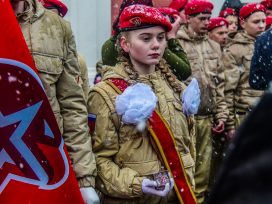
Intellectual violence
The militarization of education in Russia
Education has become another battleground in the Kremlin’s campaign to militarize the Russian public consciousness. Youth organizations, book bans, changes to school curricula – all amount to a ‘special anthropological operation’.
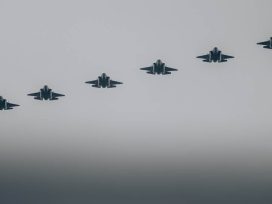
Russian drones entering Polish airspace, militarily seen as intensified provocation rather than open warfare, have nevertheless provoked costly responses – both from NATO’s air defence systems and civilian reactions to disinformation. A war correspondent’s view of what can be done technologically – for greater military efficiency and improved civil defence.

